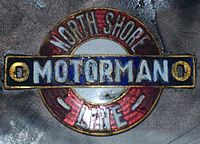| This article needs additional citations for verification. Please help improve this article by adding citations to reliable sources. Unsourced material may be challenged and removed. Find sources: "Motorman" rail transportation – news · newspapers · books · scholar · JSTOR (October 2022) (Learn how and when to remove this message) |

A motorman is a person who operates a tram (streetcar), light rail, or rapid transit train. A motorman is in charge of operating their train, applying power to traction motors, in the same sense as a railroad engineer is in charge of the engine.
The term was and, where still used, is gender-neutral. Though motormen have historically been men, women in the position (first appearing in the United States during the World Wars) were usually also called motormen as a job title. Twin City Lines adopted the diminutive "motorette" for their women employees. The term has been replaced by more neutral ones, as gender-specific job titles have fallen into disuse.
On systems such as the New York City Subway and London Underground, the position is now called "train operator" (T/O). After transitioning to one-person operation on the Chicago "L", use of "operator" came as a replacement term after motormen assumed additional responsibilities previously held by the conductors.
The operator of an electric locomotive or electric multiple unit on a commuter or mainline railroad is typically called an engineer, operator, or driver.
The term may also refer to a person on a locomotive-hauled train when the train is being propelled by the locomotive. The driver is responsible for applying power in the locomotive, while the motorman (usually in a specially-built or converted vehicle) at the front of the train, is responsible for obeying signals, sounding the horn, and applying the brakes where necessary.
References
- Diers, John W.; Isaacs, Aaron (2007). Twin Cities by Trolley: The Streetcar Era in Minneapolis and St. Paul. Minneapolis: University of Minnesota Press. p. 163. ISBN 978-0-8166-4358-5.
- Hilkevitch, Jon (24 June 1997). "CTA to leave train conductors at the station". Chicago Tribune. Retrieved 8 October 2022.
This job-, occupation-, or vocation-related article is a stub. You can help Misplaced Pages by expanding it. |